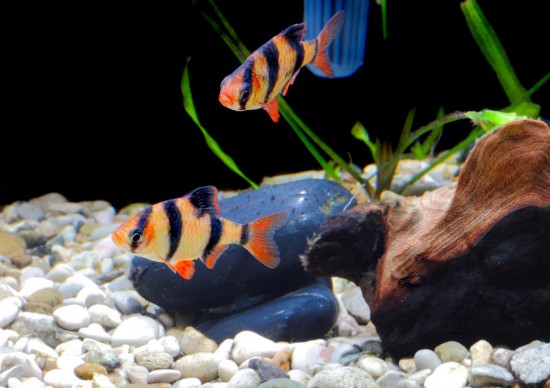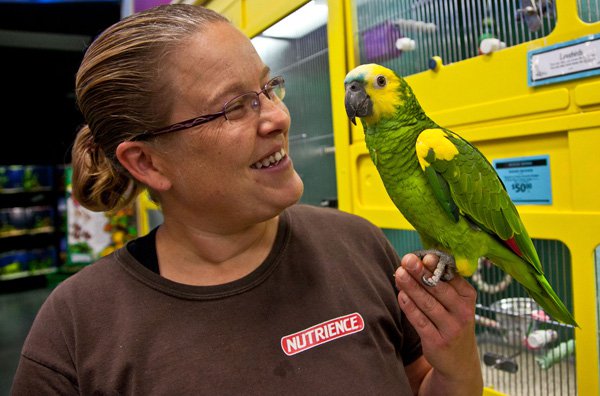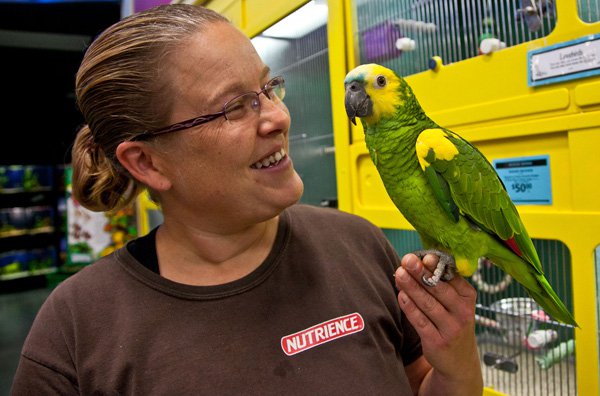

A fish tank has its own unique eco system. It is vital for the water to be well balanced to promote good bacteria and prevent bad bacteria growth. A healthy fish tank is the key to preventing tropical fish diseases.
Clean the tank every two weeks. Remove and replace 20% of the water with dechlorinated water. Clean the gravel with a gravel hose at the same time. Rinse out the filter in the water removed from the fish tank and clean algae off the tank glass with a magnetic algae cleaner. Add some liquid aquarium bacteria to put good bacteria back into the tank after cleaning. Finally, check the PH, ammonia and nitrate levels with a water testing kit.
Overcrowding, overfeeding and high nitrates and ammonia can cause fish health problems.
Do you have a new fish tank? Have you deep cleaned an existing tank? Are your fish lethargic or dying? This sounds like New Tank Syndrome. High levels of nitrate and ammonia cause this problem. New tank syndrome happens when too many new items are added at once and good bacteria have not had time to develop. This can still occur if nitrate and ammonia levels were fine before fish were added. Fish produce ammonia, which can increase to high levels if good bacteria are not present in the tank.
The first step in fixing this problem is to purchase a water testing kit and test the ammonia and nitrate levels in your tank. If the levels show positive after the test, they are too high. First check the filter and check it is functioning correctly. Next, change 10 to 20% of the water every day. Add plants as they use ammonia and add oxygen. If your fish are very lethargic, do not feed them for a day or two, as they are most probably not eating anyway. The food will increase ammonia and nitrate levels. Run the tests again daily until you get a consistent low nitrates and ammonia levels. It's best not to clean the tank thoroughly or use medications as it might kill off good bacteria which is needed to balance the tank.
Whitespot, Ich or Ick is an extremely common problem and affects all kinds of fish, including freshwater and tropical. It's contagious and fast spreading especially if the tank is overcrowded. Ich is a ciliated protozoan, which causes the white spot disease. It multiplies into hundreds of new parasites. It can only survive if there are fish in the tank as the protozoan will die if it does not attach to a host within 24 hours.
If you notice even one fish with whitespot you will need to treat the tank immediately. It's worth always keeping a supply of commercial whitespot treatment in your emergency fish supply cupboard. There are other methods such as dipping fish in aquarium, raising the tank temperature to 28°C for 24 hours and then slowly lower back to the normal running temperature over the next 24 hours. This will kill the free-swimming tomites. Do this for two weeks to ensure the adult and young parasites are killed, but check that your fish are suitable for this treatment.
Velvet looks similar to Ich, but the white spots are much smaller and slightly yellow. The spots irritate the fish and you may see it try to rub on rocks or it may gasp for air near the top of the water.
There are two stages of a velvet parasite's life. The first stage swims in the water and the second stage lives as a cyst on the fish. It propels through the water until it finds a suitable host and attaches to the gill or skin and feeds. Once it has reached cyst form it releases young or Piscinoodinium and the cycle begins again.
Most whitespot treatments also treat Velvet. Copper sulphate treatments should only be used if you do not have plants or shrimps in your tank as it kills them too. Another way to kill the velvet parasite is to add a tablespoon of aquarium salt to 5 gallons of water.
Fin rot can be caused by poor water quality or overcrowding. It can begin after another fish attacks and tears the fins or tail. The fin rot bacteria are usually dormant in the water, but manifests when a fish is stressed or injured. The bacteria will enter the injured fish through the fin or tail and looks milky white around the edges of the area. It eats at the fin membrane and then starts on the body. Other bacteria may join in to damage the weakened fish further. If your tank is unhealthy, you may notice more than one fish with this disease.
Ensure your tank contains fish that live well together to prevent further attacks.
Add aquarium salt to your tank to inhibit bacteria growth. One tablespoon of aquarium salt to five gallons of water. Do a water change of 30% to 50% of the water. This will ensure the water is healthy. Clean the filter, rocks and ornaments and hoover the gravel.
Dropsy is another highly common tropical fish disease and is often brought on by an unhealthy tank. The first sign is a swollen abdomen, scales that stick out and make the fish look like a porcupine and eyes that pop out. The visible swelling is the result of a tropical fish not able to regulate the amount of fluid in a part of its body, like the stomach or cheeks. It is often fatal at this stage, but dropsy can be treated if caught at the early stages. A fish with this disease will be lethargic, not eat and stay at the top of bottom of the tank.
High nitrates and ammonia in the water in addition to overcrowding usually cause it.
Adding aquarium salt to the tank and a commercial anti internal bacteria solution may cure the problem.
 Chicken Runs: So that Your Hens Can Roam Around Freely
Chicken Runs: So that Your Hens Can Roam Around Freely
Chicken Runs: So that Your Hens Can Roam Around Freely
Chicken Runs: So that Your Hens Can Roam Around Freely
 Welsh Springer Spaniels And Glaucoma
Welsh Springer Sp
Welsh Springer Spaniels And Glaucoma
Welsh Springer Sp
 Lurcher Health And Hereditary Wellness
Lurcher Health An
Lurcher Health And Hereditary Wellness
Lurcher Health An
 What Are Pheromones & Why Are They Important To Dogs?
What Are Pheromon
What Are Pheromones & Why Are They Important To Dogs?
What Are Pheromon
 Find the Best Ulcer Treatments For Horses
Find the Best Ulcer Treatments For Horses
Equi
Find the Best Ulcer Treatments For Horses
Find the Best Ulcer Treatments For Horses
Equi
Copyright © 2005-2016 Pet Information All Rights Reserved
Contact us: www162date@outlook.com